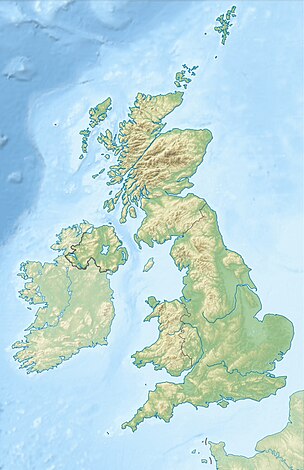| SS Empire Brigade | |
|---|---|
 As the Hannington Court, prior to 1936 | |
| Career (UK, Italy) | |
| Name: |
Hannington Court (1912–36) Elios (1936–40) Empire Brigade (1940) |
| Owner: |
United British SS Co (1912–36) Achille Lauro (1936–40) Ministry of War Transport (1940) |
| Operator: |
Haldin & Philipps (1912–36) Achille Lauro (1936–40) Cairns, Noble & Co Ltd (1940) |
| Port of registry: |
|
| Builder: | Sir John Priestman & Co Ltd, Sunderland |
| Yard number: | 239 |
| Completed: | November 1912 |
| Out of service: | 19 October 1940 |
| Identification: |
UK official number 135157 (1912–36, 1940)[1] Italian official number 462 (1936–40)[2] code letters JBDQ (1912–33)[1] call sign GRSZ (1934–36) call sign IBFO (1936–40)[2] call sign GLZS (1940)[3] |
| Fate: | Sunk by torpedo from U-99 |
| General characteristics | |
| Class & type: | cargo steamship |
| Tonnage: |
5,184 GRT tonnage under deck 4,873 3,189 NRT |
| Length: | 400.0 feet (121.9 m) |
| Beam: | 53.5 feet (16.3 m) |
| Draught: | 23 feet 9 inches (7.24 m) |
| Depth: | 26.6 feet (8.1 m) |
| Installed power: | 440 NHP |
| Propulsion: | triple-expansion steam engine; single screw |
| Speed: | 10 knots (19 km/h) |
| Crew: | 41 |
SS Empire Brigade was a 5,184 GRT cargo ship that was built in 1912 as SS Hannington Court. She served through the First World War and was sold in 1936 to Achille Lauro, who renamed her Elios. In 1940 when Italy declared war on France and the United Kingdom she was interned by the UK as a war prize and taken over by the Ministry of War Transport (MoWT), which renamed her Empire Brigade. Four months later she was torpedoed and sunk by U-99.
Building[]
The shipyards of Sir John Priestman & Co Ltd, Southwick, Sunderland built the ship in 1912. She was launched as Hannington Court on 10 October 1902 and completed in November 1912.[4] She was 400.0 feet (121.9 m) long, with a beam of 53.5 feet (16.3 m) and a depth of 26.6 feet (8.1 m). She had nine corrugated furnaces with a combined grate area of 192 square feet (18 m2) that heated three 180 lbf/in2 single-ended boilers with a combined heating surface of 7,158 square feet (665 m2). These fed a single three-cylinder triple-expansion steam engine built by Blair and Co Ltd of Stockton-on-Tees. The engine had cylinders of 27 inches (69 cm), 44.5 inches (113 cm) and 74 inches (190 cm) bore by 48 inches (120 cm) stroke, was rated at 440 NHP and gave the ship a speed of 10 knots (19 km/h)[4]
Peacetime career[]
Hannington Court's original owner was United British Steamship Co, which registered her in London and appointed Haldin and Philipps to manage her. The business was dubbed "Court Line" for its custom of giving all its ships names that ended in "Court". In 1936 Court Line sold her to Achille Lauro's Flota Lauro, which renamed her Elios and registered her in Naples.
On 10 June 1940 Italy declared war on France and the UK and invaded France. Elios was in port in Newcastle, where the UK authorities seized her as a war prize. The Ministry of War Transport, renamed her Empire Brigade, registered her in Newcastle and appointed Cairns, Noble & Co Ltd to manage her.
Wartime career and loss[]
In October 1940 Empire Brigade, with Sydney Parks as her Master, loaded a cargo of 750 tons of copper, 129 tons of ferrous alloy and 980 tons of steel at Montreal in Canada and then sailed to Sydney, Nova Scotia where she joined Convoy SC-7 which was bound for Liverpool. Empire Brigade's cargo was bound for Leith via the Tyne.
The convoy left Sydney on 5 October 1940, initially with only one escort ship, the Hastings-class sloop HMS Scarborough. A wolf pack of U-boats found the convoy on 16 October and quickly overwhelmed it, sinking many ships over the next few days. Empire Brigade survived until 0138 hrs on 19 October, when U-99 torpedoed and sank her in the Western Approaches about 100 nautical miles (190 km) east-southeast of Rockall. Out of a complement of 41, five crew members and one DEMS gunner were killed.
The Shoreham-class sloop HMS Fowey rescued her Master and 34 crew members and landed them at Greenock.[5][6] Those killed on Empire Brigade are commemorated at the Tower Hill Memorial in London.[7]
References[]
- ↑ 1.0 1.1 "Steamers & Motorships". Lloyd's Register. 1930. http://www.plimsollshipdata.org/pdffile.php?name=30b0505.pdf. Retrieved 28 November 2008.
- ↑ 2.0 2.1 "Steamers & Motorships". Lloyd's Register. 1938. http://www.plimsollshipdata.org/pdffile.php?name=38b0276.pdf. Retrieved 28 November 2008.
- ↑ "Steamers & Motorships". Lloyd's Register. 1940. http://www.plimsollshipdata.org/pdffile.php?name=40a1056.pdf. Retrieved 28 November 2008.
- ↑ 4.0 4.1 "1135157". Miramar Ship Index. http://www.miramarshipindex.org.nz. Retrieved 10 December 2009. (subscription required)
- ↑ "Empire Brigade". Uboat. http://uboat.net/allies/merchants/625.html. Retrieved 10 December 2009.
- ↑ "Convoy SC 7". Convoyweb. http://www.warsailors.com/convoys/sc7.html. Retrieved 10 December 2009.
- ↑ "Ship Index A-F". Brian Watson. http://www.benjidog.co.uk/Tower%20Hill/Ship%20Index%20A-F.html. Retrieved 20 May 2011.
| |||||||||||||||||||||||
Coordinates: 57°12′N 10°43′W / 57.2°N 10.717°W
The original article can be found at SS Empire Brigade and the edit history here.
